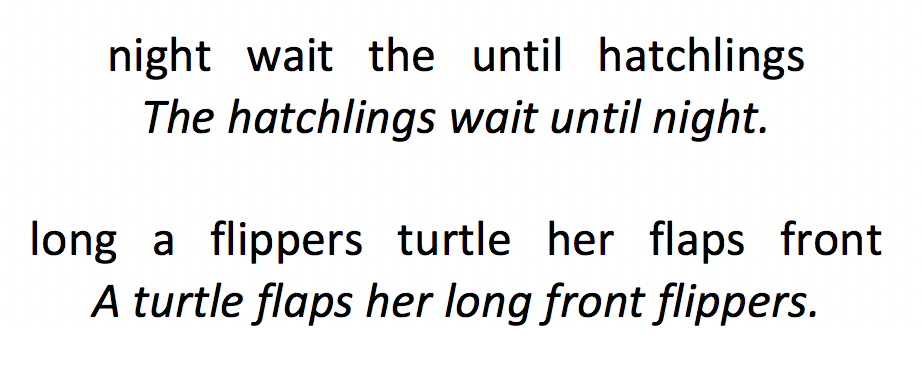

The ability to understand at the sentence level is in many ways the foundation for being able to comprehend text. The ways in which authors express their ideas through sentences greatly affects a reader’s ability to access and identify those ideas. Sentences that are complex, contain a large number of ideas (also called propositions), or have unusual word order will make it difficulty for students to comprehend what they are reading, especially students who enter school with limited oral language exposure or for whom English is a second language. Consider this:
Sentence knowledge is also important for student composing (oral or written). As Saddler (2012) explains it, “Of the many difficulties writers encounter when engaged in the complex act of writing, crafting sentences that accurately convey the meaning is particularly challenging…. manipulating sentences is both effortful and critical.”
Syntactic Awareness
Syntax is the study and understanding of grammar — the system and arrangement of words, phrases, and clauses that make up a sentences. In order to comprehend a sentence, the reader must process, store (in working memory), and integrate a variety of syntactic and word meaning information (Paris & Hamilton, 2009).
Syntactic awareness means having the ability to monitor the relationships among the words in a sentence in order to understand while reading or composing orally or in writing. Students build syntactic awareness through exposure to oral language when they are young and particularly through exposure to written language that they hear through read aloud or independent reading (around grade 3).
Activities to Develop Syntactic Awareness
There are several instructional activities that can help students develop “sentence sense” (i.e., syntactic awareness) by providing opportunities for students to manipulate and add words in sentences.
Sentence Scramble
During a sentence scramble activity, students arrange words to form a sentence. Students are given a set of words from a sentence that are out of order. They must then arrange the words into a complete sentence that follows correct English grammar. Words cannot be deleted. Here are two examples:

Here are a few suggestions for using sentence scrambles with your students:
Sentence Elaboration: The “W” Questions
Sentence elaboration activities help students use and manipulate a growing number of words in sentences (Marilyn Adams, 2011). They are especially helpful for developing syntactic awareness for subordinate clauses, prepositional phrases, and adverbial phrases. A basic sentence elaboration activity uses six question words: who, what, where, why, which, how. The activity starts with a simple subject (e.g., the turtle). Then, a series of questions is asked to prompt students to expand and elaborate. This activity can be done in whole group with students making suggestions while the teacher writes the sentences. For older students, this activity can be done in small groups or with partners. Scaffold by giving students just two or three of the question words, then gradually expand the task.
Here is an example:

The sources for these activities are two Keys to Literacy professional development programs: The Key Comprehension Routine: Grades K-3, and Keys to Early Writing. Click here to learn more about these programs and order the books. In next month’s post I will share two more activities that building syntactic awareness: Kernel Sentence Elaboration and Sentence Combining.
Adams, M.J. (2011). Reading, language, and the mind. PowerPoint delivered at NYSED Network Team Institute, November 29, 2011, Albany, NY.
Saddler, B. (2012). Teacher’s guide to effective sentence
writing. New York: Guilford Press.
Scott, C. (2004). Syntactic
contributions to literacy development. In C. Stone, E. Stillman, B. Ehren,
& K. Apel (Eds.) Handbook of language
and literacy pp 340-363. New York:
Guilford Press.
Snow, C., Griffin, P., & Burns, M.S. (eds.). (2005). Knowledge to Support the Teaching of Reading. San Francisco: Jossey-Bass.

Joan Sedita is the founder of Keys to Literacy and author of the Keys to Literacy professional development programs. She is an experienced educator, nationally recognized speaker and teacher trainer. She has worked for over 35 years in the literacy education field and has presented to thousands of teachers and related professionals at schools, colleges, clinics, and professional conferences.